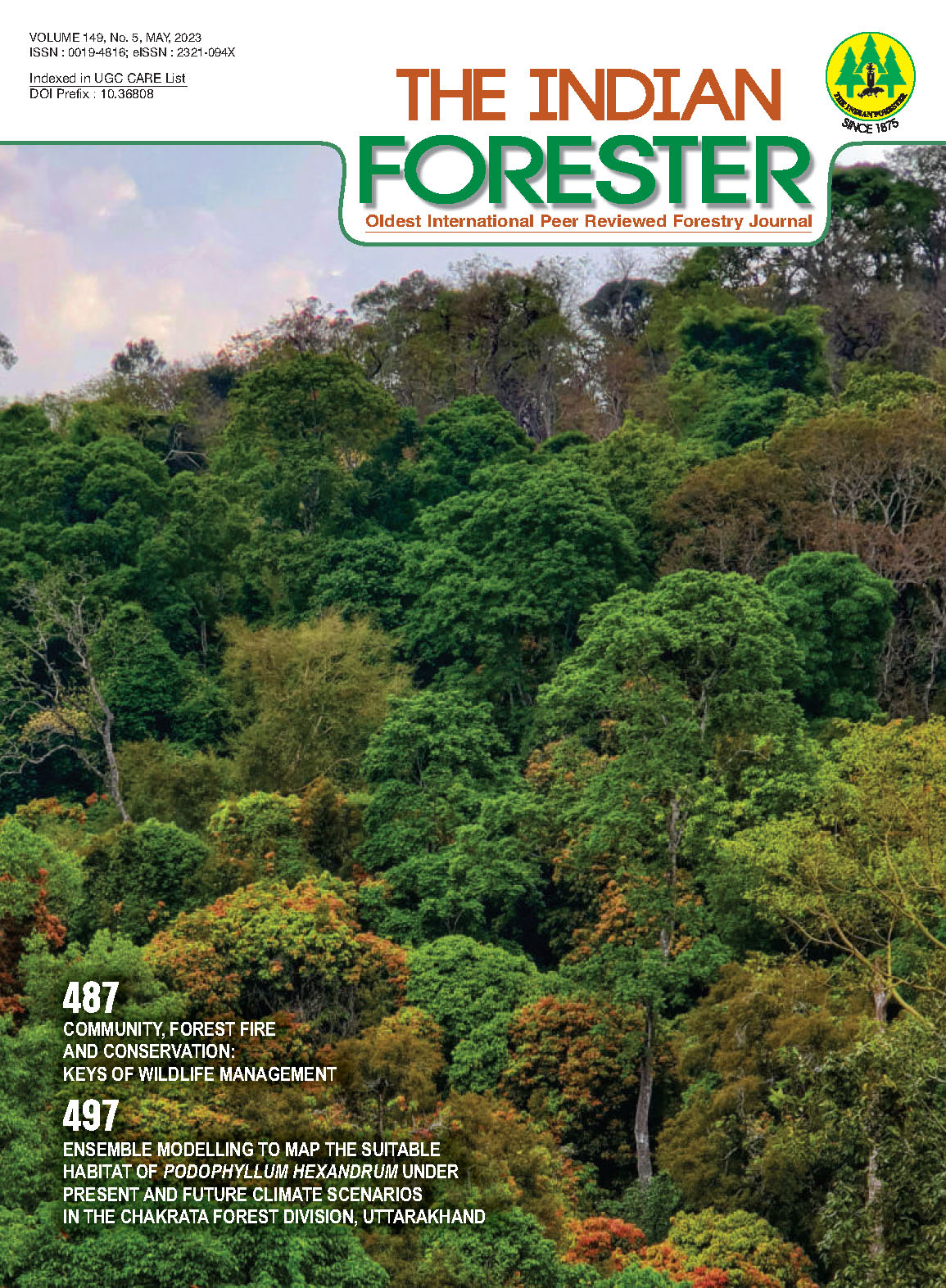First Report of the Bicolored Ant Tetraponera rufonigra Jerdon on Aquilaria malaccensis Tree
DOI:
https://doi.org/10.36808/if/2023/v149i5/168779Keywords:
CITES, Cytochrome c oxidase, Polymerase Chain Reaction, IUCN.Abstract
The formation of the tunnels due to feeding by the insect Zeuzera conferta Walker in Aquilaria malaccensis Lam, a critically endangered tree, facilitates harbouring space for some insects that are yet to be studied in the context of the host environment. This is the first report of the association of the bicolored ant, Tetraponera rufonigra Jerdon with the Aquilaria malaccensis tree, which is commonly known as agarwood. The ant is an issue for agarwood tree producers in Assam, India, especially during the extraction process of the resinous agarwood due to stinging attacks. The ant was identified using mitochondrial cytochrome c oxidase subunit I (COXI) gene sequencing. In the tunnels, the agarwood tree provides nesting space for the ants, and the ants may respond by guarding the tree from herbivores. If this particular relationship of the ant T. rufonigra is confirmed by future research, it could lead to new insights into the formation of agarwood resins as a result of insect activity.References
Baksha M.W. and Islam M.R. (1999). Biology and ecology of Zeuzera conferta Walker (Cossidae: Lepidoptera) infesting Sonneratia apetala plantations in Bangladesh. Bangladesh Journal of Forest Science, 28(2): 75-81.
Borthakur N.D., Borah R.K., Dutta B.K. and Jayaraj R.S.C. (2021). Neurozerra conferta Walker. (Beehole Borer) on Aquilaria malaccensis Lamk. in Assam. Indian Forester, 147(3): 276-280.
CITES Appendices I, II and III. Downloaded on 20 July 2021. CITES Appendices I, II and III valid from 14.02.2021
Davidson D.W., Cook S.C., Snelling R.R. and Chua T.H. (2003). Explaining the abundance of ants in lowland tropical rainforest canopies. Science, 300(5621): 969-972.
Gathalkar G.B. and Sen A. (2018). Foraging and Predatory Activities of Ants. The complex world of ants. IntechOpen, London, UK, 51-70pp.
Guerrieri E. and Noyes J. (2005). Revision of the European species of Copidosoma Ratzeburg (Hymenoptera: Encyrtidae), parasitoids of caterpillars (Lepidoptera). Systematic Entomology, 30(1): 97-174.
Harvey-Brown Y. (2018). Aquilaria malaccensis. The IUCN Red List of Threatened Species 2018: e.T32056A2810130. https://dx.doi.org/10.2305/IUCN.UK.2018-1.RLTS. T32056A2810130.en. Downloaded on 20 July 2021.
Hui T.H., Yanling W.W. and Kiat T.S. (2019). Bi-coloured arboreal ants apparently feeding on eggs of apple snail. Singapore Biodiversity Records, 166-167.
Janzen D.H. (1966). Coevolution of mutualism between ants and acacias in central America. Evolution, 20(3): 249–275.
Kalita J., Bhattacharyya P.R., Boruah H.D., Unni B.G., Lekhak H. and Nath S.C. (2015). Association of Zeuzera conferta Walker on agarwood formation in Aquilaria malaccensis Lamk. Asian Journal of Plant Science and Research, 5(1): 4-9.
Khakhlari A. and Sen S. (2021). Articulating Fragrant Agarwood Formation as an Outcome of the Interaction between the Insect Zeuzera conferta and Aquilaria trees–A Review. Journal of Natural Resources, 4(3): 62-78.
Lau K.H. and Ong S.P. (2019). Aquilaria malaccensis (Malvales: Thymelaeaceae): a new host plant record for Deudorix epijarbas cinnabarus (Lepidoptera: Lycaenidae) in Malaysia. Journal of Threatened Taxa, 11(10): 14385-14387.
Lee S.Y. and Mohamed R. (2016). The origin and domestication of Aquilaria, an important agarwood-producing genus. In Agarwood, Springer, Singapore, pp. 1-20.
Naephrai S., Khacha-Ananda S., Pitchakarn P. and Jaikang C. (2021). Composition and Acute Inflammatory Response from Tetraponera rufonigra Venom on RAW 264.7 Macrophage Cells. Toxins, 13(4): 257.
Naziz P.S., Das R. and Sen S. (2019). The scent of stress: Evidence from the unique fragrance of agarwood. Frontiers in plant science, 10: 840.
Norasmah B., Chin Y.J. and Hassan A.A. (2012). A preliminary study on the diurnal foraging activity and nutrient preferences of Tetraponera rufonigra (Hymenoptera: Formicidae) in Pulau Pinang, Malaysia. Malaysian Applied Biology, 41(1): 51-54.
Ong S.P., Cheng S.H.A.W.N., Chong V.C. and Yee-Siang T. (2010). Pests of planted mangroves in Peninsular Malaysia. Forest Research Institute Malaysia, 5-23pp.
Rhind J.P. (2014). Fragrance and wellbeing: Plant aromatics and their influence on the psyche. London: Singing Dragon, 412-429pp.
Roy S., Muraleedharan N. and Pujari D. (2014). A catalogue of arthropod pests and their natural enemies in the tea ecosystem of India. Two and a Bud, 61(1 and 2): 11-39.
Sabtu F.S. and Majid A.H.A. (2020). Genetic distance and Phylogenetic relationship of Tetraponera rufonigra Jerdon (Hymenoptera: Formicidae) populations in Penang, Malaysia. Serangga, 25(1): 39-52.
Sinu P.A., Mandal P. and Antony B. (2011). Range expansion of Hyposidra talaca (Geometridae: Lepidoptera), a major pest, to Northeastern Indian tea plantations: change of weather and anti-predatory behaviour of the pest as possible causes. International Journal of Tropical Insect Science, 31(4): 242-248.
Somala N., Senarat S., Para C., Jiraungkoorskul W., Kaneko G., Poonpet T. and Poolprasert P. (2020). Systemic organization of Tetraponera rufonigra (Jerdon, 1851) (Hymenoptera: Formicidae): Histological observation. Serangga, 25(1): 53-67.
Stuben P.E. and Astrin J.J. (2012). Integrative taxonomy, phylogeny, and new species of the weevil genus Onyxacalles Stüben (Coleoptera: Curculionidae: Cryptorhynchinae). Psyche, 2012: 1-22.
Syazwan S.A., Lee S.Y., Ong S.P. and Mohamed R.O.Z.I. (2019). Damaging insect pests and diseases and their threats to agarwood tree plantations. Sains Malaysiana, 48(3): 497-507.
Tawfik H.M. and Ramadan H.M. (2006). New species of Hyssopus (H. aegyptiaca sp. n.) (Hymenoptera: Eulophidae: Eulophinae) parasitizing the leopard moth larvae, Zeuzera pyrina L. (Lepidoptera: Cossidae). Egyptian Journal of Biological Pest Control, 16(1/2): 73-77.
Vanitha K., Bhat P.S., Raviprasad T.N. and Srikumar K.K. (2017). Species Composition of Ants in Cashew Plantations and their Interrelationships with Cashew. Proceedings of the National Academy of Sciences, India Section B: Biological Sciences, 87(2): 399-409.
Zhang L., Brockelman W.Y. and Allen M.A. (2008). Matrix analysis to evaluate sustainability: The tropical tree Aquilaria crassna, a heavily poached source of agarwood. Biological Conservation, 141(6): 1676-1686.
Downloads
Downloads
Published
How to Cite
Issue
Section
License
Unless otherwise stated, copyright or similar rights in all materials presented on the site, including graphical images, are owned by Indian Forester.





